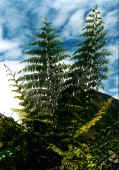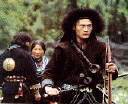Day 4 QIANGBALIN
TEMPLE: The principle monastery of the Gelu sect
in Eastern Tibet.
Day 5 DINOSAUR
POSSILS: In the mountain of Damala, close to roam
the coastal regions of a long--vanished sea.
Day 6 TENGCHEN
-- BACHEN: The capital town of North Tibet. A station
on the Qinghai -- Tibet Highway. 4500 meters above sea
level. A vast expanse of grassland. A long tradition of
wild horse races across the plains.
Day 7 NAKCHU:
The capital town of North Tibet. A station on the Qinghai
-- Tibet Highway. 4500 meters above sea level. A vast
expanse of grassland. A long tradition of wild horse races
across the plains.
Day 8 NAKCHU
-- DAMSHUNG -- LHASA: The South route of the QT highway.
A straight, broad road making vehicle tour comfortable
and easy, despite the wildness of the surrounding countryside. Day
9 NAMTSO:
The largest saltwater lake in Tibet. 4718 meters above
sea level. The Nianchen Tanggala Peak. 7111 meters high,
stands at the south bank of the lake, a spectacular sight.
In spring and summer, the lake throngs with nesting birds.
A vast tract of grassland surrounds the lake. Herds roam
free. One of the three holy lakes in Tibet. Attracts a
great number of Buddhist pilgrims.
Natural
Environment of Eastern Tibet:
This area is a transition from plateau to mountains. Nakcha
in the upper reaches of the Nujiang and Lanchangjiang
rivers. The area includes the Lanchangjiang River, Yarlung
Tsangpo River and their tributaries. Heading eastward
off the plateau into the mountains, the average elevation
descends from 5000 to 4000 meters. Canyon depths are from
2000 - 2500 meters. The deepest is over 6000 meters.
The corner canyon was named the deepest in the world by
a team of U.S geologists in 1994.
The plants in Eastern Tibet are grade - separated. They
range from tropical forest in the lower reaches to snow
-- deserts in the most elevated areas. The great canyon
area has been put under national protection for purposes
of preservation and scientific study.
There are nearly 6000 species of plants and animals in
the area, including 110 woody plant, 116 mammal, 473 bird,
49 reptile, 44 amphibian, 61 fish, and 2300 insect species.
Many of these species are unique, not found outside China.
River Valleys: Lujiang, Nachang, Jinsha valleys. Tall
mountains, steep valley sides, steep river drops, many
waterfalls. Valley floors vulnerable to flooding. Plants
are grade - s eparated. Primitive production methods still
employed by the local populations. Economical backward,
it is now the recipient of vitalization efforts that include
the development of 340 million kilowatt of hydro - electric
capacity. Mountain, forest, river and folklore photographic
tours are favorites with our customers in the past. The
best amateur travel times is April to November. Scientific
expedition choose their times according to study needs,
of course. We travel anytime. eparated. Primitive production methods still
employed by the local populations. Economical backward,
it is now the recipient of vitalization efforts that include
the development of 340 million kilowatt of hydro - electric
capacity. Mountain, forest, river and folklore photographic
tours are favorites with our customers in the past. The
best amateur travel times is April to November. Scientific
expedition choose their times according to study needs,
of course. We travel anytime.
|

